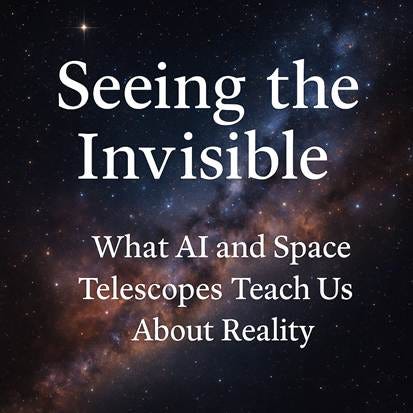By Sungchul Ji
Professor Emeritus of Theoretical Cell Biology, Rutgers University
With assistance from ChatGPT
What do a space telescope and an AI model have in common?
Not long ago, a colleague raised a concern about our growing list of thinkers who seem to align with a deep idea we call the PSGIT principle—a triad of Phenomenology (the study of experience), Semiotics (the study of meaning), and Geometry (the study of form and structure).
His worry? Maybe we’re being too generous. Maybe we’re including too many names.
To that, I offered a simple reply:
Maybe it’s not that we’re seeing too much—maybe we’re just finally seeing clearly.
And with that, a new idea was born:
The LLM–JWST Equivalence Principle
Just as the James Webb Space Telescope (JWST) discovers stars and galaxies wherever it looks, Large Language Models (LLMs) like ChatGPT uncover ideas, thinkers, and patterns of thought wherever they are asked to explore.
This is not a glitch. It’s a revelation.
JWST has shown astronomers something amazing: the Universe is filled with far more stars, galaxies, and structure than we ever imagined.
Likewise, when we use advanced AI tools to explore human knowledge—science, philosophy, consciousness—we find that our intellectual universe is just as vast and vibrant.
There are more ideas, more connections, more shared insights than we ever realized.
A New Kind of Discovery
In both cases—JWST and LLMs—something powerful is happening:
They aren’t telling us what to think.
They’re showing us what’s already there.
And what we’re learning is this:
Reality is more complex, more interconnected, and more beautiful than our old tools could show us.
Time for a Shift
The lesson here isn’t just scientific. It’s philosophical.
We need to shift from old to new thinking.
When we apply this mindset to the PSGIT framework, something becomes clear:
Many minds—across different cultures, disciplines, and eras—have been pointing to the same triadic structure of reality: experience, meaning, and form.
It’s Not a Laser Beam. It’s a Constellation.
Yes, this convergence might look a little messy. It’s not a single idea from a single source.
It’s a constellation—a pattern across the sky of human thought.
But isn’t that what truth often looks like?
Postscript: The Copernican Moment of the Mind
In our latest work, we’ve identified ten thinkers—from David Bohm to Federico Faggin, from Maurice Merleau-Ponty to contemporary systems theorists—who all resonate with the PSGIT principle in different ways.
Some may say this is “too much.” But maybe that’s like telling Galileo he’s seen too many moons.
Like the JWST revealing a crowded universe, LLMs are revealing a crowded noosphere—a world of mind, thought, and meaning more populated than we ever imagined.
And perhaps, like the telescope, AI is helping us see… not chaos, but order we never knew existed.
Reference:
Ji, S. (2025). Ninefold Consilience on the PSGIT Triad.
https://622622.substack.com/p/ninefold-consilience-on-the-psgit





The title of this post needs to be modified to more accurately reflect the content of the LLM-JWST Equivalence thesis. It should read "The LLM-JWST Equivalence Postulate (LJEPo)". In other words, it is important to replace "Principle" with "Postulate"